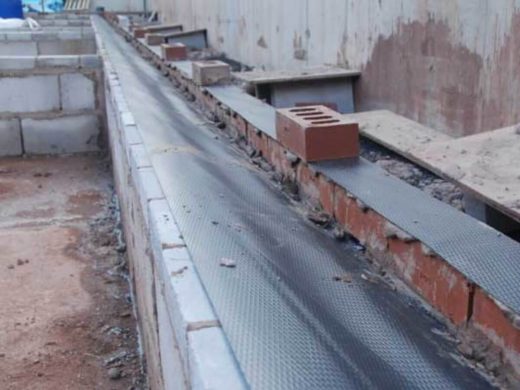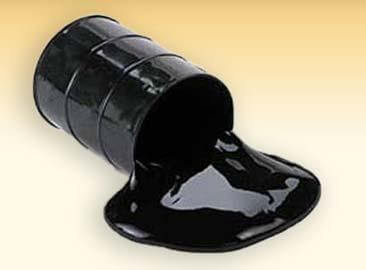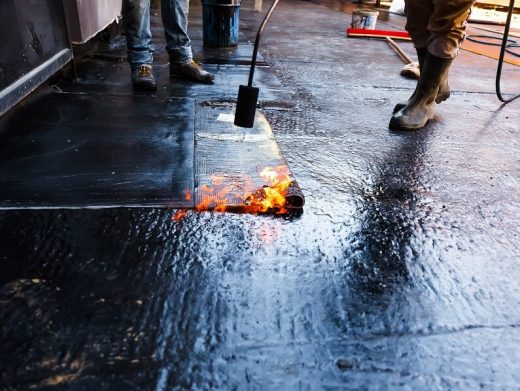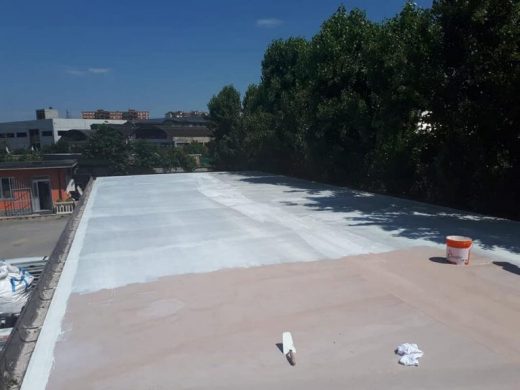Introduction
Damp Proof Course or DPC is the protective layer applied to prevent the rising of moisture to the walls from the ground due to capillary action. It is usually 2.5 cm thick with a ratio of rich cement concrete 1:1.5:3 or 2 cm thick with cement mortar 1:2 mixed with standard waterproofing material. It is provided from the plinth level to the entire width of the plinth wall, and the quantities are calculated in square meters (length x breadth). Usually, DPC is not provided at the sills of doors and verandah openings, for which deductions are made. In most cases, 1 kg of cem-seal, Impermo, or another definitive waterproofing compound is used per bag of cement.

Fig 1: DPC laying
Courtesy: DecorChamp
Materials
The damp proof course is composed of cement, coarse sand, and stone aggregate in a ratio of 1:1.5:3 with 2% impermo, cem-seal, or Acco proof by weight of cement or another standard waterproofing compound (1 kg per bag of cement). The damp proof course should be applied in a horizontal layer of 2.5 cm thickness at the plinth level. Fresh portland cement, as per traditional standards, is used in preparing DPC. The sand to be used must be clean and coarse, with a particle size of 5 mm or less, and the stone aggregate must be solid and rigid, with a particle size of 20 mm, well-graded, and free of dust and filth. Composeal, pudlo, cico, and other typical waterproofing compounds may be used, with the quantity following the manufacturer’s instructions.
Mixing
By measuring with measuring boxes, mixing is done on a masonry platform or a sheet-iron tray in the proportion of 1:1.5:3. The cement is first wholly mixed with the waterproofing compound to the desired quantity, then dried and blended in a ratio of 1:1.5 with the sand. The cement and sand mixture is then dry mixed with stone aggregate in the proportion of 1:1.5:3. Clean water is gently and gradually added to the needed quantity while stirring to produce a plastic mix with the required workable consistency. To achieve a uniform and homogenous concrete mixture, the mixing must be done at least three times.
Laying
While laying the damp proof course, the level of the plinth’s surface must be checked longitudinally and transversely. The damp proof course should be applied to the top of the walls with frogs of the brick downward. Side forms or shuttering of 2.5 cm thick and solid wooden battens should be fixed firmly and adequately on both sides to confine the concrete so that the shuttering is not disturbed during compaction and mortar does not leak through. To prevent concrete from adhering to the inner edges of the shuttering, it must be oiled. Before laying concrete, the wall’s surface must be cleaned, and the masonry must be wetted with water.
The concrete must be applied within half an hour of mixing and thoroughly compacted by tamping to produce dense concrete level both longitudinally and transversely. After two hours of laying, the concrete surface should be rough and chequered in order to form a key with the wall above. The damp-proof course must be applied in one continuous day with no joints. If in case joints or breaks are unavoidable, they must be provided at the sills of doors or openings. If joints cannot be avoided, they must be sloped, and the sloped surface must be applied with neat cement wash just before the next day’s concreting. After three days, the shuttering can be removed. When the shuttering is removed, the edges should be smooth and free of honeycombing.
Curing
The damp proof course is to be watered and kept wet for 7 days before the wall’s construction can begin. Before beginning masonry, the surface must be cleaned and wetted to apply the damp proof course with a smooth texture.
Painting with Asphalt
If specified, two coats of asphalt paint may be applied to the upper surface of the damp proof course. When the concrete is dry, it is required to apply the first coat of hot asphalt at 1.5 kg per sq m (15 percent kg per sq ft) uniformly to the surface. The painted surface is immediately blinded with coarse sand, and the texture is lightly tamped. The second coat of hot asphalt should be applied uniformly at 1 kg per sq m (10 kg per sq ft), and the surface should be immediately blinded with coarse sand and lightly tamped.
2 cm Damp proof course
The damp proof course can be a 2 cm (4″) thick layer of 1:2 cement and coarse sand mortar with standard waterproofing compound at a rate of 1 kg per cement bag. The mixing, laying, curing, and so on must be carried out in the same manner. The form or shuttering must be two centimeters thick so that the DPC can be laid down at a perfect level.
Some common materials used in the Damp Proof Course
- Hot bitumen – This is a highly flexible material with a minimum thickness of 3 mm. It is applied to the bedding of concrete or mortar while it is hot.
- Mastic asphalt – It is a semi-rigid, highly durable, and entirely waterproof material. It’s made by heating asphalt, sand, and mineral fillers together. It should, however, be laid very carefully by expert people as it can only take a minor amount of distortion. In a hot climate or under extreme pressure, it’s prone to squeeze out, so proper care should be taken.
- Bituminous or asphaltic felts – This is a flexible material that is available in rolls of various wall thicknesses. It is applied on a uniform flat layer of cement mortar. An overlap of 10 cm is provided at joints, and complete width overlap is provided at angles, junctions, and crossings. The laps should be sealed with bitumen. Bituminous felts cannot withstand heavy loads, though they can accommodate slight movements.
- Metal sheets – Lead, copper, and aluminum sheets can be utilized as DPC. These sheets are made of a flexible material and are pretty flimsy. Their thickness should be such that their weight per square meter does not go below 20 kg/m2. They are laid in the same manner as bituminous felts. Lead sheets have the advantages of being entirely immune to moisture, being resistant to ordinary air corrosion, taking complicated shapes without cracking, and resisting sliding. Under normal pressure, it does not squeeze out. When it comes into contact with lime or cement, it can rust, and hence, a bituminous coating should be applied to protect it. Copper sheets with a thickness of at least 3 mm are placed in lime or cement mortar as it offers a high level of durability, moisture resistance, slide resistance, and everyday pressure resistance. If aluminum sheets are used, a layer of bitumen should be applied to protect them. However, aluminum does not perform as good as to lead or copper sheets.
Combination of sheets and bituminous felts – When the lead foil is sandwiched between asphaltic or bituminous felts used as a DPC, it can prove effective. This combination, known as the leading core, is easy to lay, durable, efficient, economical, and crack resistant.
- Bricks – In places where the damp is not excessive, special bricks with water absorption not less than 4% of their weight may be used as DPC. These bricks are placed in cement mortar in two to four strokes, and the brick joints are maintained open.
- Stones – Granite, trap, slates, and other dense and sound stones are set in two courses or layers in cement mortar (1:3) to make efficient D.P.C. The stones should stretch throughout the wall width.
- Mortar – A bedding layer of cement mortar (1:3) is utilized to house other DPC. materials. A small amount of lime can be added to improve the workability of the mortar. 75 grams of soft soap per liter of water is dissolved in the mixing water used in DPC. This mortar can also be used for external wall plastering.
- Cement concrete – To work as DPC, cement concrete of 1:2:4 mix or 1:1:3 mix is usually delivered at two plinth levels. The thickness can range from 4 to 15 centimeters. A coating like this can successfully prevent water from rising due to capillary action. Where there is a lot of moisture, two layers of hot bitumen paint can be used.
- Plastic sheets – This is a relatively new form of DPC material, consisting of black polythene with a thickness of 0.5 to 1 mm in the standard walling width and 30 m roll lengths. C.B.R.I Roorkee has recently proposed a new DPC, which consists of a 400 gauge thick alkaline placed over a 12 mm thick 1:4 cement mortar. Although the treatment is less expensive, it is not permanent.

Fig 2: Hot Bitumen
Courtesy: Exporters India

Fig 3: Mastic Asphalt
Courtesy: Southern Damp Proofing

Fig 4: Bitumen felt
Courtesy: Winkler
Conclusion
Dampness in buildings can lead to the attack of termites, rusting and corrosion of metal fittings, cracking in walls, electrical fittings getting damaged, leaking sealants, and many more problems that can lead to loss of money when not treated in time. There are many methods of DPC that can be applied to prevent dampness of any form inside the building. It can hinder future construction works, too, if implemented in the building for extending rooms, changing the house plan, etc. Thus, the Damp Proof Course must be of good quality and sturdy.
References
- Cementconcrete.org, “Damp Proof Course (DPC) – Methods of DPC application in Construction”- https://cementconcrete.org/building-construction/damp-proofing-course-dpc/2561/
- Building Construction, 10th Edition by Dr. B. C. Punmia, er. Ashok K. Jain, Dr. Arun K. Jain, Laxmi Publications (P) LTD.
- Estimating and Costing in Civil Engineering Theory and Practice, Twenty-Eighth Revised Edition by B N Dutta. UBS Publisher’s Distributors Pvt. Ltd.
If you have a query, you can ask a question here.


